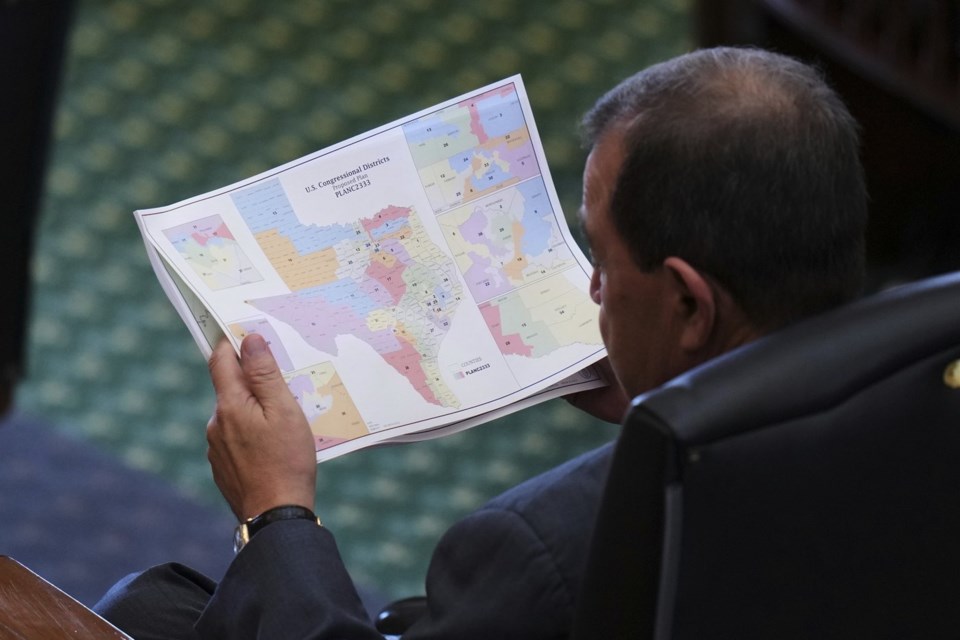AUSTIN, Texas (AP) — Texas Republicans were aiming Friday to give final passage to an unprecedented mid-decade redraw of the state’s congressional map and send it to Gov. Greg Abbott’s desk for final approval ahead of the 2026 elections.
Debate in the GOP-controlled Senate stretched into Friday afternoon, as Democrats attempted to delay the bill’s passage. Still, the proceedings remained far more subdued than the fiery showdown in the House that sparked a broader, state-by-state redistricting battle, with governors from both parties pledging to redraw their congressional maps.
Democrats spent hours pressing state Sen. Phil King, the measure's sponsor, on the legality of the proposal, with many alleging that the redrawn districts violated the Voting Rights Act by diluting voters’ influence based on race — an accusation King vehemently denied.
“I had two goals in mind: That all maps would be legal and would be better for Republican congressional candidates in Texas,” said King.
California Democrats landed their counterpunch to Texas on Thursday, just a day after Texas Republicans advanced their redrawn map that had come at the urging of President Donald Trump with the aim of padding their House majority by five seats.
Lawmakers in California voted mostly along party lines to approve legislation calling for a special election in November to approve a redrawn congressional map designed to help Democrats win five more U.S. House seats next year. California's map needs voter approval because, unlike in Texas, a nonpartisan commission normally draws the map to avoid the sort of political battle that is playing out.
California Gov. Gavin Newsom, who rallied Democrats in his state to counter Texas’ initial moves, quickly signed the special election bill. If Republicans in Texas finalize their map Friday, Abbott is expected to follow suit.
The back-and-forth between the two states marks the starkest escalation yet in an emerging redistricting war, with both parties openly redrawing congressional lines to lock in power ahead of the 2026 midterm elections.
Abbott on Friday called California's redistricting “a joke” and said that while Texas' new map is constitutional, he claimed California's would be overturned.
Newsom said Thursday that the measure “is a reaction to an assault on our democracy in Texas,” and pledged a campaign that would reach out to Democrats, Republicans and independent voters.
“This is not something six weeks ago that I ever imagined that I’d be doing,” he said.
California Republicans have sued and called for a federal investigation. They promise to fight the measure at the ballot box as well.
California Assemblyman James Gallagher, the Republican minority leader, said Trump was “wrong” to push for new Republican seats elsewhere, contending the president was responding to Democratic gerrymandering in other states. But he warned that Newsom’s approach, which the governor has dubbed “fight fire with fire,” was dangerous.
“You move forward fighting fire with fire and what happens?” Gallagher asked. “You burn it all down.”
A battle for US House control waged via redistricting
On a national level, the partisan makeup of existing districts puts Democrats within three seats of a majority. The incumbent president’s party usually loses congressional seats in the midterms.
The Texas redraw is already reshaping the 2026 race, with Democratic Rep. Lloyd Doggett, the dean of Texas’ congressional delegation, announcing Thursday that he will not seek reelection to his Austin-based seat if the new Republican-drawn map takes effect. Under the proposed map, Doggett's district would overlap with another Democratic incumbent, Rep. Greg Casar.
The president has pushed other Republican-controlled states including Indiana and Missouri to also revise their maps to add more winnable GOP seats. Ohio Republicans were also already scheduled to revise their maps to make them more partisan.
“Republicans are not finished in the United States,” Abbott said Friday.
Redistricting typically occurs once a decade, immediately after a census. While some states have their own limitations, there is no national impediment to a state trying to redraw districts in the middle of the decade.
The U.S. Supreme Court has said the Constitution does not outlaw partisan gerrymandering, only using race to redraw district lines.
“What is allowed by the Supreme Court is drawing (districts) for political reasons,” Abbott said. "These were drawn by Republicans for political reasons to assure that Republicans would have better representation in Congress.”
Democrats have sought a national commission for redistricting
Republicans and some Democrats championed the 2008 ballot measure that established California’s nonpartisan redistricting commission, along with the 2010 one that extended its role to drawing congressional maps.
Newsom, who backed the initial redistricting commission ballot measures, contended his state was still setting a model.
“We’ll be the first state in U.S. history, in the most democratic way, to submit to the people of our state the ability to determine their own maps,” Newsom said before signing the legislation.
Former President Barack Obama, who has also backed a nationwide nonpartisan approach, has also backed Newsom’s bid to redraw the California map, saying it was necessary to stave off the GOP’s Texas move.
More Democratic-run states have commission systems like California’s or other redistricting limits than Republican ones do, leaving the GOP with a freer hand to swiftly redraw maps. New York, for example, can’t draw new maps until 2028, and even then, only with voter approval.
Earlier this month, outnumbered Texas Democrats left the state for 15 days to block a vote. Once they returned, they were assigned round-the-clock police monitoring.
——
Riccardi reported from Denver. Austin and Nguyen reported from Sacramento, California. Associated Press reporter Joey Cappelletti in Washington, D.C., also contributed.
Jim Vertuno, Sophie Austin, Trân Nguyễn And Nicholas Riccardi, The Associated Press


